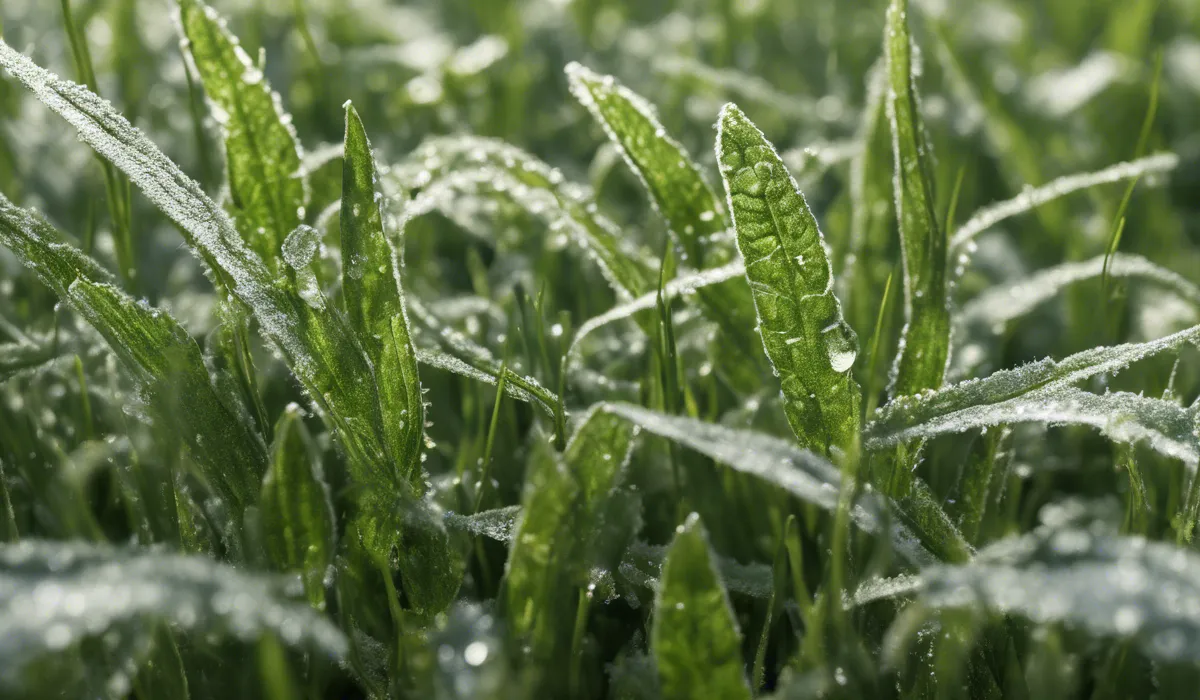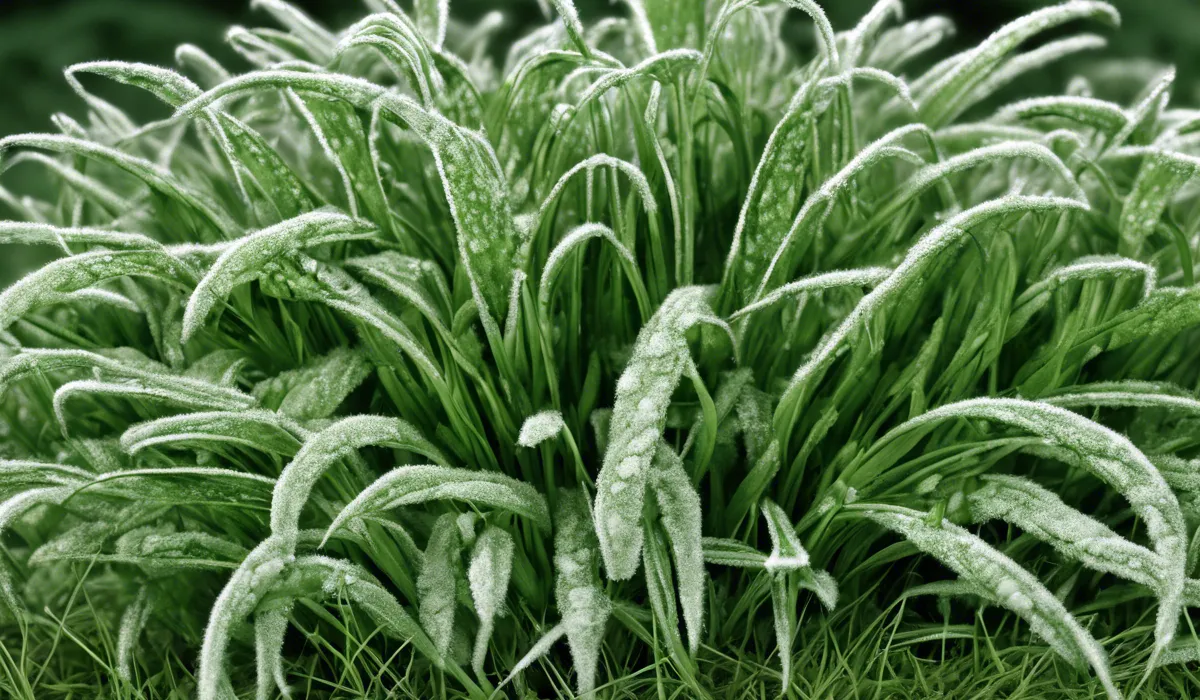Powdery mildew on grass is caused by fungal pathogens thriving in humid, low-light conditions. Poor air circulation and overcrowded plants contribute to its spread. It often affects grass in shaded areas with cool temperatures.
Causes of Powdery Mildew on Grass

Fungal Pathogens
Powdery mildew on grass is primarily caused by a group of fungal pathogens, with Erysiphe graminis being one of the most common culprits.
These fungi thrive in specific conditions that are often found in grassy areas. They reproduce rapidly, creating a white or gray powdery substance on the blades of grass which is a telltale sign of the disease.
These pathogens are obligate parasites, meaning they require a living host to survive. This characteristic underscores the importance of maintaining healthy grass to prevent the establishment and spread of powdery mildew.
Host Range
While powdery mildew can affect a variety of plants, certain grasses are more susceptible to this fungus than others.
Kentucky bluegrass, fescues, and ryegrasses, for instance, are often affected in residential lawns.
The susceptibility of these grass types to powdery mildew makes it crucial for lawn owners and gardeners to be vigilant, especially in areas where these grasses are prevalent.
The best defense against the spread of powdery mildew starts with understanding which grasses are at risk and monitoring them for signs of the disease.
Environmental Conditions Favoring Powdery Mildew

Humidity and Moisture
Moisture in the air, or humidity, plays a pivotal role in the growth of fungi, including those causing powdery mildew.
High humidity levels, particularly when paired with cool temperatures, create an environment where powdery mildew can thrive.
However, unlike many other fungi, powdery mildew does not require the presence of free water on the leaves for infection to occur.
Instead, the high humidity around the grass is sufficient for the spores to germinate. Factors that affect humidity levels, such as watering practices and local climate, must be managed to reduce the risk of powdery mildew development.
Temperature
The optimal temperature range for powdery mildew development on grass is usually between 60 to 72 degrees Fahrenheit.
These moderate temperatures, often found during spring and fall, create an ideal setting for fungal growth.
Understanding the temperature preferences of powdery mildew can help in planning the right time for preventative measures, as well as predicting when outbreaks may occur.
Air Circulation
Poor air circulation can exacerbate the severity of powdery mildew by allowing humid conditions to persist.
Stagnant air contributes to the creation of microclimates that are more humid and favorable to the fungus.
Ensuring good air movement around grassy areas can thus be an effective strategy in reducing the risk of powdery mildew.
Simple practices such as spacing plants properly and regular pruning can significantly improve air flow.
Shade and Light
Shaded areas and low light conditions are often associated with increased incidences of powdery mildew.
Grass under trees or in the shadow of buildings receives less sunlight, which can result in cooler temperatures and reduced evaporation of moisture, providing a hospitable environment for the fungus.
Managing the amount of light that reaches the grass, perhaps by selective pruning of trees or shrubs, can help minimize the risk of powdery mildew.
Cultural Practices and Plant Health

Overcrowding and Planting Density
Dense planting can lead to conditions that favor the development of powdery mildew by reducing air circulation and increasing humidity among plants.
Overcrowded grass areas are more susceptible to powdery mildew, as the close proximity of grass blades allows the fungus to spread more easily.
Thinning out grassy areas can help prevent the disease by creating an environment less conducive to fungal growth.
Nutrient Management
Proper fertilization and maintaining soil health are crucial in preventing fungal diseases like powdery mildew.
A well-balanced supply of nutrients strengthens grass, enabling it to better resist infection.
Over-fertilization, particularly with nitrogen, can lead to lush but weak growth that is more susceptible to disease.
Conversely, under-fertilization can stress the grass, also increasing susceptibility. Soil testing and following recommended fertilization schedules are key to maintaining plant health and disease resistance.
Watering Practices
Irrigation is essential for healthy grass, but it must be done wisely to minimize the risk of powdery mildew.
Watering early in the morning allows the grass to dry out during the day, which reduces humidity levels around the grass blades.
Avoiding evening watering is advisable, as it can leave the grass damp throughout the night, creating an environment that is more favorable for powdery mildew growth.
Mowing and Maintenance
Regular mowing and lawn maintenance play a significant role in preventing powdery mildew and other diseases.
Mowing helps to improve air circulation and reduces humidity within the grass canopy. It is important to mow at the recommended height for the specific type of grass, as cutting too short can stress the grass and make it more prone to disease.
Keeping mowing equipment clean and well-maintained can also prevent the spread of fungal spores from one area of the lawn to another.
FAQs About Powdery Mildew on Grass
What environmental conditions lead to powdery mildew on grass?
Powdery mildew on grass is typically caused by humid conditions, low light, and cool temperatures.
How does poor air circulation affect powdery mildew development in grass?
Poor air circulation can increase humidity and promote the growth and spread of the fungal pathogens responsible for powdery mildew.
Can overcrowding of plants contribute to powdery mildew on grass?
Yes, overcrowded plantings can restrict airflow and create a more favorable environment for powdery mildew to thrive and spread.
What types of areas are more susceptible to powdery mildew in grass?
Grass in shaded areas that are cooler and have less direct sunlight are more susceptible to powdery mildew.
What is the main cause of powdery mildew on grass?
The main cause of powdery mildew on grass is the presence of fungal pathogens that thrive in specific conditions such as high humidity, low light, and cool temperatures.
Final Thoughts
Powdery mildew on grass is induced by fungal pathogens that favor moist, shaded environments with poor air circulation.
Overcrowded plantings exacerbate the situation, making it a common issue in cooler, less sunlit areas.
Effective management requires modifying these environmental conditions to inhibit fungal growth and spread.
